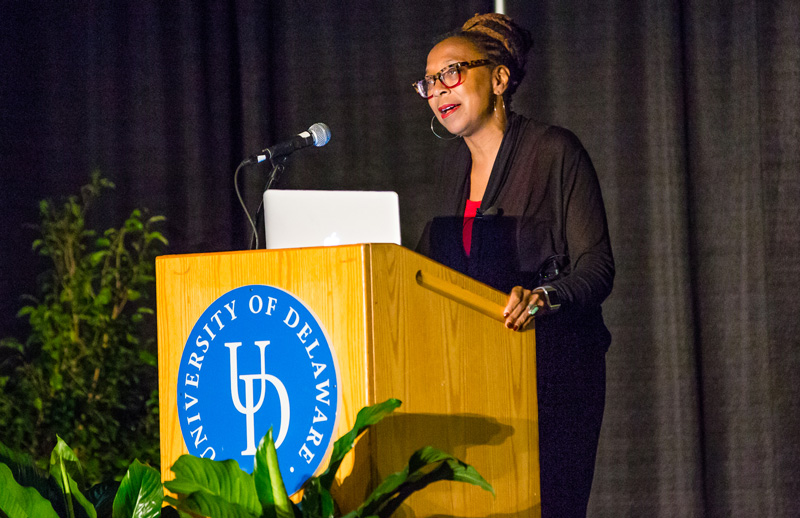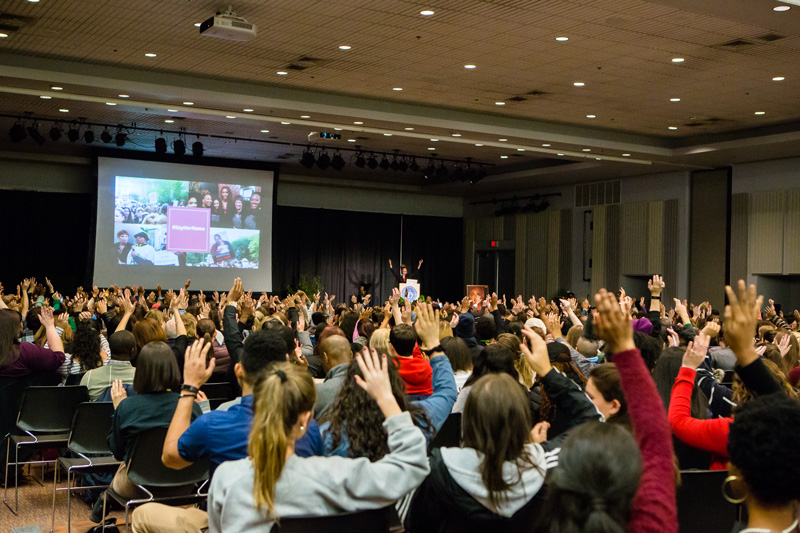


The intersectional struggle of black women
Photo by Jess Eastburn February 28, 2018
Activist and law professor Kimberlé Crenshaw speaks on black women in the civil rights movement
In 1989, Kimberlé Crenshaw coined the term intersectionality, which refers to the overlapping identities of individuals that influence their experience with discrimination. In a lecture on Thursday, Feb. 22 in the Trabant University Center at the University of Delaware, Crenshaw reflected on what this means in the context of the civil rights movement since Martin Luther King Jr.’s death 50 years ago.
Crenshaw, a law professor at UCLA and Columbia, started the lecture by talking about the joys and pains she feels during February.
“It is an honor, but it’s also a challenge to speak during Black History Month in the midst of what I call the most profound unravelling of racial justice we’ve seen since the end of the first reconstruction,” Crenshaw said. “I don’t know about you, but every day seems to bring about news of another setback.”
Crenshaw’s lecture was part of the annual Black History Month Extravaganza hosted by the Center for Black Culture, which celebrated black history and the 50-year anniversary of 1968 — a pivotal year during the civil rights movement.
During her hour long speech, Crenshaw addressed intersectionality, particularly that faced by black women. People understand the struggles of women as one group and black men as another, she said, but when it comes to black women -- who are represented under both identities -- there is a disconnect.
As she steered the audience through the years since 1968, she highlighted the names of many of the black women that were wrongfully vilified. She mentioned Shirley Sherrod, the former Georgia state director of rural development for the U.S. Department of Agriculture. Sherrod was fired in 2010 after the right-wing news outlet Breitbart posted an edited video which created a racist slant on a speech Sherrod gave. Crenshaw said while this was already bad, then-President Barack Obama and the NAACP quickly called for Sherrod’s dismissal instead of backing her. It later came to light that her remarks were taken out of context, but the damage was already done.
To further demonstrate her point, Crenshaw used two visual aids. First, she showed a picture of sick cows and asked who is to blame. Naturally you would blame the farmer, she said. She then widened the frame of the same picture, to reveal smoke stacks billowing black smog into the air. With this new information the blame shifts.
“Broadening the frame allows us to see more clearly how many societal issues are the product of societal taxes, exclusions built on the aftermath of segregation and the continued impact of discrimination and the like,” Crenshaw said.
For the other demonstration, she asked the audience to raise their hands and lower them once they heard a name they do not recognize. She started to list the names of now famous black men that made headlines after becoming victims of police brutality. “Michael Brown, Tamir Rice, Eric Garner, Philando Castile...” Most hands stayed up. She then went on to name women that were victims of the same tragedy. “Michelle Cusseaux, Tanisha Anderson, Mya Hall, Kayla Moore…” It was not long before most of the hands in the audience were down.
“These are all black women who have lost their lives at the hands of police,” Crenshaw said. “Yet many don’t know their names.
“What kind of movement can you base on the experience of one person? To understand a social problem we have to confront all aspects of it. Including the fact that black women and girls have been killed in every conceivable way.”
Throughout the lecture, audience members snapped in approval and offered Crenshaw affirming “mm-hmms” as she spoke. Crenshaw said the fight is not over and action is still needed. Before leaving to a standing ovation, she ended her motivational lecture with one question: “How can we not?”

Contact Us
Have a UDaily story idea?
Contact us at ocm@udel.edu
Members of the press
Contact us at 302-831-NEWS or visit the Media Relations website

